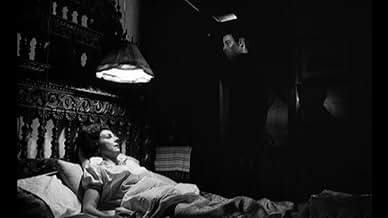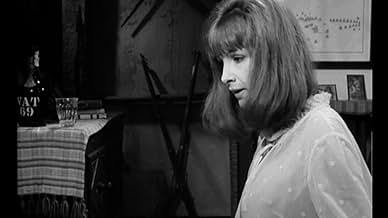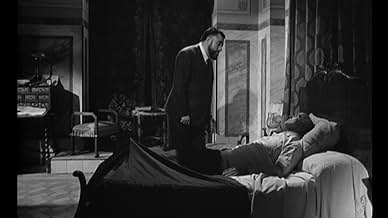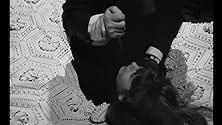IMDb-BEWERTUNG
5,4/10
680
IHRE BEWERTUNG
Füge eine Handlung in deiner Sprache hinzuA mad scientist creates a hideous monster to carry out his murderous plans.A mad scientist creates a hideous monster to carry out his murderous plans.A mad scientist creates a hideous monster to carry out his murderous plans.
Hugo Blanco
- Andros
- (as Hugh White)
Magda Maldonado
- Amira
- (as Magda MacDonald)
Pepe Rubio
- Juan Manuel
- (as José Rubio)
Javier de Rivera
- The Professor
- (as Javier Rivera)
Empfohlene Bewertungen
1964's "Dr. Orloff's Monster" (El Secreto del Dr. Orloff or Les Maitresses du Docteur Jekyll), a Spanish-French-Austrian coproduction and sequel (the first in a lengthy series) to Jesus Franco's 1961 "The Awful Dr. Orlof," basically a continuation of the same outline, murderous undead assassin stalking pretty showgirls in various stages of undress. A similar castle setting finds Marcelo Arroita-Jauregui's evil Dr. Conrad Jekyll (no Hyde in evidence, his name changed to Fisherman in other territories) ruling his beaten down wife, who has been grieving for her lost love over the decades, in fact the doctor's own beloved brother Andros (Hugo White), now his robotic pawn drawn to each victim by a radio transmitting necklace that police prove slow to pick up on (a lost necklace was also a catalyst in the original ORLOF). Only when he tries to murder his visiting niece Melissa (Agnes Spaak) does he meet his fate at the hands of her protective father, though one wonders how Andros would recognize his now adult daughter after being, well, dead for so many years! Andros isn't as fearful as the original film's Morpho (Ricardo Valle), but he does prove more sympathetic and has the benefit of sight where his predecessor was blind. This doctor is a real cold fish, addicted to opium, lacking even the menacing qualities of Howard Vernon, who would reprise the Orloff role on many occasions into the 80s, plus a well meaning surgeon in Claude Mulot's unrelated French title "The Blood Rose." A perfunctory love interest for Melissa helps flesh out her character, Agnes Spaak the elder sister of Catherine Spaak, who would soon retire from the screen to work as a photographer. This early Franco shows that he was capable of good work with a decent budget, and without the dizzying zoom lens that would become his trademark.
If you've suffered through some of the hack work Jess Franco cranked out in the last two decades, you may find it difficult to believe that he once took some pride in his craft and evinced a certain mastery of cinematic technique, as well as a modicum of discipline. "Dr Orloff's Monster" is a case in point. Despite the title, it bears no direct relation to the creepy and perverse opus, "The Awful Dr Orloff", which put the director on the map back in the early 60s. However, it shares the same doom-laden aura -- with the expected (but always riveting) kinky asides -- that so resemble that earlier picture as well as the German Edgar Wallace 'krimi' series which was reaching its peak at the same time.
The picture is rife with carefully-executed camera angles and atmospherics, something that would become anathema to Franco's slash-and-burn methods of the 80s. The best scenes are reminiscent of (dare I say) Lewton and Franju. It builds up a strong pathos for the title character, thanks to a subtle, wordless portrayal that evokes Cesar in 'Cabinet of Dr Caligari' and Christiane in 'Eyes without a Face' (such homages were a Franco specialty). There is a particularly poignant sequence in which the zombie stumbles about near his own tombstone in a bleak, wintry cemetery. No matter what depths Franco's movies plunged to, they always offered a few wonderfully oddball cabaret scenes in smoky jazz or rock bars, and this is no exception. One singer performs a wacky, rhythmic Latin ditty that must have sparked the imagination of the members of the retro band 'Les Rita Mitsouko'. (These cabaret scenes were a welcome staple of the Euro-thriller genre of the 60s, also perking up the krimi series, several of the campier works of the Italian Gothic revival, and especially the outlaw melodramas of Jose Benazeraf.)
There are already foreshadowings of the director's latter-day carelessness -- a few too many zooms, cutting from the middle of one scene to another, and a general neglect of motivation. And, of course, he'd end up doing the revenge plot to death. But overall, this one (along with the much more perverse 'Sadistic Baron von Klaus') comes highly recommended for Franco skeptics and genre fans alike. Surprisingly, this film was immediately followed by his magnum opus, the delirious 'Succubus' (aka 'Necronomicon'), which in its pseudo-sophisticated Radley-Metzger-like style is miles removed from the Gothic horror of his early work.
The picture is rife with carefully-executed camera angles and atmospherics, something that would become anathema to Franco's slash-and-burn methods of the 80s. The best scenes are reminiscent of (dare I say) Lewton and Franju. It builds up a strong pathos for the title character, thanks to a subtle, wordless portrayal that evokes Cesar in 'Cabinet of Dr Caligari' and Christiane in 'Eyes without a Face' (such homages were a Franco specialty). There is a particularly poignant sequence in which the zombie stumbles about near his own tombstone in a bleak, wintry cemetery. No matter what depths Franco's movies plunged to, they always offered a few wonderfully oddball cabaret scenes in smoky jazz or rock bars, and this is no exception. One singer performs a wacky, rhythmic Latin ditty that must have sparked the imagination of the members of the retro band 'Les Rita Mitsouko'. (These cabaret scenes were a welcome staple of the Euro-thriller genre of the 60s, also perking up the krimi series, several of the campier works of the Italian Gothic revival, and especially the outlaw melodramas of Jose Benazeraf.)
There are already foreshadowings of the director's latter-day carelessness -- a few too many zooms, cutting from the middle of one scene to another, and a general neglect of motivation. And, of course, he'd end up doing the revenge plot to death. But overall, this one (along with the much more perverse 'Sadistic Baron von Klaus') comes highly recommended for Franco skeptics and genre fans alike. Surprisingly, this film was immediately followed by his magnum opus, the delirious 'Succubus' (aka 'Necronomicon'), which in its pseudo-sophisticated Radley-Metzger-like style is miles removed from the Gothic horror of his early work.
Dr. Orloff's Monster (1964)
** (out of 4)
Jess Franco's sequel to The Awful Dr. Orloff is more of a remake than anything else. I watched the French version under the title The Mistress of Dr. Jekyll and this version features more nudity than the versions released in Spain and America. In the film. Dr. Fisherman (Marcelo Arroita Jauregui) kills his brother (Hugo Blanco) when he learns that he is having an affair with his wife. The doctor eventually brings his brother back as a zombie like creature to kill various women for him. I've never really been a fan of Franco's earlier period of Gothic horror films but you can certainly see that he has talent with these films. While I prefer his 70s work he does give this film a lot of style, which is something missing from those later films. The performance Blanco is pretty good but Jauregui comes off very boring and certainly can't fill the shoes of Howard Vernon from the previous film. The film is beautiful to look at and features a very nice score from Daniel White but in the end the film left me looking at my watch too much. The movie's pace is quite slow and all the stuff dealing with the police comes off boring. You can spot Franco during one scene. The DVD features some of the alternate scenes from the American and Spanish version of the film. I think I prefer the French scenes with the nudity as it makes the film stand out from countless other Gothic films of this period.
** (out of 4)
Jess Franco's sequel to The Awful Dr. Orloff is more of a remake than anything else. I watched the French version under the title The Mistress of Dr. Jekyll and this version features more nudity than the versions released in Spain and America. In the film. Dr. Fisherman (Marcelo Arroita Jauregui) kills his brother (Hugo Blanco) when he learns that he is having an affair with his wife. The doctor eventually brings his brother back as a zombie like creature to kill various women for him. I've never really been a fan of Franco's earlier period of Gothic horror films but you can certainly see that he has talent with these films. While I prefer his 70s work he does give this film a lot of style, which is something missing from those later films. The performance Blanco is pretty good but Jauregui comes off very boring and certainly can't fill the shoes of Howard Vernon from the previous film. The film is beautiful to look at and features a very nice score from Daniel White but in the end the film left me looking at my watch too much. The movie's pace is quite slow and all the stuff dealing with the police comes off boring. You can spot Franco during one scene. The DVD features some of the alternate scenes from the American and Spanish version of the film. I think I prefer the French scenes with the nudity as it makes the film stand out from countless other Gothic films of this period.
In THE MISTRESSES OF DR. JEKYLL (aka: DR. ORLOFF'S MONSTER), the demented title character kills, then turns his cheating wife's lover into a remote control zombie robot. He then sends his new zombot out to slaughter various ladies of the night.
Enter the Doctor's niece, who arrives for a visit. Unbeknownst to her, it's her dad that's now a reanimated murderer!
Director Jesus Franco has really made a great horror film here. It's dark and bizarre, and the method used to facilitate the killings is ingenious! There's a macabre atmosphere and many genuinely creepy moments. The finale is also quite satisfying...
Enter the Doctor's niece, who arrives for a visit. Unbeknownst to her, it's her dad that's now a reanimated murderer!
Director Jesus Franco has really made a great horror film here. It's dark and bizarre, and the method used to facilitate the killings is ingenious! There's a macabre atmosphere and many genuinely creepy moments. The finale is also quite satisfying...
Nice Franco film revolving around a nutty doctor , Orloff , aka Jekyll , who sends his disfigured monster to attack beautiful women from nightclubs . It begins with the gorgeous teen Melissa (Agnès Spaak) travels from Austria and meets the Spanish Juan Manuel (Pepe Rubio) , who flirts with her , and going to the mysterious house of her uncle Dr. Conrad Jekyll (Marcelo Arroita-Jáuregui) in Holfen to spend Christmas with him , while he intends to transfer the inheritance to her . There Melissa meets the burnt-out and bittered aunt Inglud (Luisa Sala) who has dark secrets , too . Meantime, a police inspector (Pastor Serrador) and underlings (José Truchado, Ramón Lillo) to discover the real culprit , by investigating the complex cases about killed women and going after some suspicious people . Thanks to the help his girlfriend , the young Juan Manuel ((José Rubio or Pepe Rubio) finds out the prime suspect , who results to be Dr. Conrad Jekyll (Marcelo Arroita-Jáuregui) or Dr. Orloff , assisted by a horrific servant (Hugo Blanco who has a decent make-up) to execute his murderous schemes .
Austerily wonderful horror film about an ordinary Franco plot , as a mad scientist creates an ominous monster , being currently helped by the creepy servant , a deformed and hideous monstrosity . It contains thrills , chills , haunting poetic fantasy and deemed to be one of the first movies of the ¨Spanish Fantaterror¨ . In this enjoyable tale titled ¨The Orloff's secret¨ as well as the former eerie flick ¨The awful Dr Orloff¨, Franco established his uniquely poetic and visually striking style , though imitating to classy "Eyes Without A Face" (1960) , the masterpiece directed by George Franju , while in ¨The Awful Dr. Orlof¨(1962) by Franco himself , Orloff removes the faces of gorgeous girls and attempts to graft them onto the ruined head of his disfiguring daughter . This decent Spanish/French co-production is generally characterized by unforgettable images that owed a great deal to early cinema in general and German Expressionism in particular and turns out to be a symbolic attack on the ethics of science . Although the film passed European censors upon its original release in 1964 , the disturbing attacks and erotic scenes still caused controversy , existing a double version , both , a light Spanish and another hard French one . Nice acting by sympathetic and wonderful Agnès Spaak ; excellent and eerie Hugo Blanco as Andros a monster turned into a killer zombie controlled by ultrasonic radio wave , fine Marcelo Arroita-Jáuregui as a brilliant and demented researcher/scientific/surgeon haunted by past tragedy and likeable Pepe Rubio as the brave boyfriend . And a lot of familar Spanish faces giving attractive support cast , such as : Perla Cristal , Pastor Serrador , José Truchado , Ramon Lillo, Marta Reves , Manuel Guitián , Maribel Hidalgo , Julio Infiesta , Rafael Hernández . And brief appearance , as usual , by Jesus Franco or Jess Frank as a pianist at a bar .
Tenth film of the prolific writer/producer/director Jesús Franco , considered to be one of the best films in his first period . Well produced but in short budget by Leo Films , Nueva Films S. A. (Spain) and the French company run by Daniel and Marious Lesoeur : Eurocine . Stunningly filmed in black and white by cameraman Alfonso Nieva , using continuous lights , shades and expressionist darkness . Shot on location in San Martín de Valdeiglesias, Castillo de la Coracera , Madrid, Spain , posing as the fictitious French town of Hartog . This vintage terror motion picture , a classic in some circles , was well directed by Jesús Franco who never considered the film to be a horror story, but instead felt it was tale of "anguish" . Franco is really influenced by ¨Eyes without a face¨, B-movies about Detectives or Noir Films , German expressionism from Cabinet Dr Caligari , and the Universal Terror . Initial releases of the film were met with negative reactions from film critics , while the general critical reaction had been poor , however , today being considered to be a pretty good fim.
The Orloff character as a mad doctor who tries to use skin of murdered women to repair his beloved daughter's fire-scarred face and whose role subsequently to show up in various flicks starring a long saga , using the same shots in more than one film ; some of his actors relate how they they were hired for one film and later saw their name in two or more different one . Orloff is often assisted by Morpho , Andros-lookalike, who delights in killing his victims and sadistic practices . Orloff was habitually played by Howard Vernon who initiated in ¨Gritos en la Noche (1962) , the best of all them , also titled "The Awful Dr. Orlof" . It's followed by El Secreto del Dr. Orloff (1964) aka "The Mistresses of Dr. Jekyll" - USA . It's gone on by " Orloff y el hombre invisible (1970) aka "Dr. Orloff's Invisible Monster" , ¨Ojos siniestros de Doctor Orloff¨(1973) . Furthermore , El enigma Del Ataúd (1969) aka "Only a Coffin" and El Siniestro doctor Orloff (1984) aka "The Sinister Dr. Orloff . Finally in ¨Faceless¨ or Depredadores de Noche¨(1987) Orloff appears as a secondary role also performed by Howard Vernon.
Austerily wonderful horror film about an ordinary Franco plot , as a mad scientist creates an ominous monster , being currently helped by the creepy servant , a deformed and hideous monstrosity . It contains thrills , chills , haunting poetic fantasy and deemed to be one of the first movies of the ¨Spanish Fantaterror¨ . In this enjoyable tale titled ¨The Orloff's secret¨ as well as the former eerie flick ¨The awful Dr Orloff¨, Franco established his uniquely poetic and visually striking style , though imitating to classy "Eyes Without A Face" (1960) , the masterpiece directed by George Franju , while in ¨The Awful Dr. Orlof¨(1962) by Franco himself , Orloff removes the faces of gorgeous girls and attempts to graft them onto the ruined head of his disfiguring daughter . This decent Spanish/French co-production is generally characterized by unforgettable images that owed a great deal to early cinema in general and German Expressionism in particular and turns out to be a symbolic attack on the ethics of science . Although the film passed European censors upon its original release in 1964 , the disturbing attacks and erotic scenes still caused controversy , existing a double version , both , a light Spanish and another hard French one . Nice acting by sympathetic and wonderful Agnès Spaak ; excellent and eerie Hugo Blanco as Andros a monster turned into a killer zombie controlled by ultrasonic radio wave , fine Marcelo Arroita-Jáuregui as a brilliant and demented researcher/scientific/surgeon haunted by past tragedy and likeable Pepe Rubio as the brave boyfriend . And a lot of familar Spanish faces giving attractive support cast , such as : Perla Cristal , Pastor Serrador , José Truchado , Ramon Lillo, Marta Reves , Manuel Guitián , Maribel Hidalgo , Julio Infiesta , Rafael Hernández . And brief appearance , as usual , by Jesus Franco or Jess Frank as a pianist at a bar .
Tenth film of the prolific writer/producer/director Jesús Franco , considered to be one of the best films in his first period . Well produced but in short budget by Leo Films , Nueva Films S. A. (Spain) and the French company run by Daniel and Marious Lesoeur : Eurocine . Stunningly filmed in black and white by cameraman Alfonso Nieva , using continuous lights , shades and expressionist darkness . Shot on location in San Martín de Valdeiglesias, Castillo de la Coracera , Madrid, Spain , posing as the fictitious French town of Hartog . This vintage terror motion picture , a classic in some circles , was well directed by Jesús Franco who never considered the film to be a horror story, but instead felt it was tale of "anguish" . Franco is really influenced by ¨Eyes without a face¨, B-movies about Detectives or Noir Films , German expressionism from Cabinet Dr Caligari , and the Universal Terror . Initial releases of the film were met with negative reactions from film critics , while the general critical reaction had been poor , however , today being considered to be a pretty good fim.
The Orloff character as a mad doctor who tries to use skin of murdered women to repair his beloved daughter's fire-scarred face and whose role subsequently to show up in various flicks starring a long saga , using the same shots in more than one film ; some of his actors relate how they they were hired for one film and later saw their name in two or more different one . Orloff is often assisted by Morpho , Andros-lookalike, who delights in killing his victims and sadistic practices . Orloff was habitually played by Howard Vernon who initiated in ¨Gritos en la Noche (1962) , the best of all them , also titled "The Awful Dr. Orlof" . It's followed by El Secreto del Dr. Orloff (1964) aka "The Mistresses of Dr. Jekyll" - USA . It's gone on by " Orloff y el hombre invisible (1970) aka "Dr. Orloff's Invisible Monster" , ¨Ojos siniestros de Doctor Orloff¨(1973) . Furthermore , El enigma Del Ataúd (1969) aka "Only a Coffin" and El Siniestro doctor Orloff (1984) aka "The Sinister Dr. Orloff . Finally in ¨Faceless¨ or Depredadores de Noche¨(1987) Orloff appears as a secondary role also performed by Howard Vernon.
Wusstest du schon
- VerbindungenFeatured in Son of Svengoolie: Dr Orloff's Monster (1981)
Top-Auswahl
Melde dich zum Bewerten an und greife auf die Watchlist für personalisierte Empfehlungen zu.
Details
- Erscheinungsdatum
- Herkunftsländer
- Sprache
- Auch bekannt als
- Die Lebenden Leichen des Doktor Jekyll
- Drehorte
- Produktionsfirmen
- Weitere beteiligte Unternehmen bei IMDbPro anzeigen
- Laufzeit1 Stunde 30 Minuten
- Farbe
- Sound-Mix
- Seitenverhältnis
- 1.66 : 1
Zu dieser Seite beitragen
Bearbeitung vorschlagen oder fehlenden Inhalt hinzufügen

Oberste Lücke
By what name was Dr. Orloff's Monster (1964) officially released in India in English?
Antwort

























